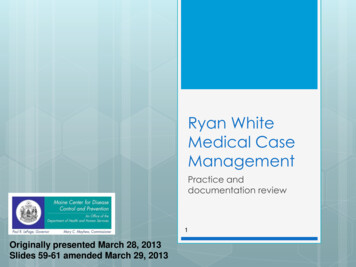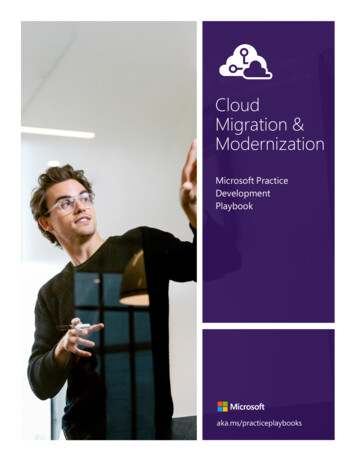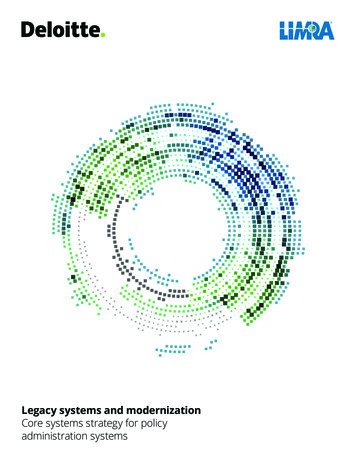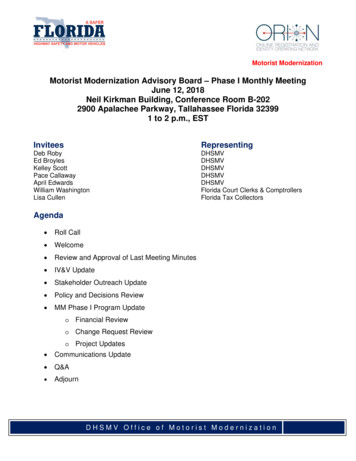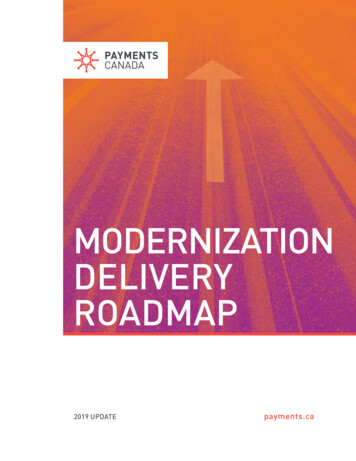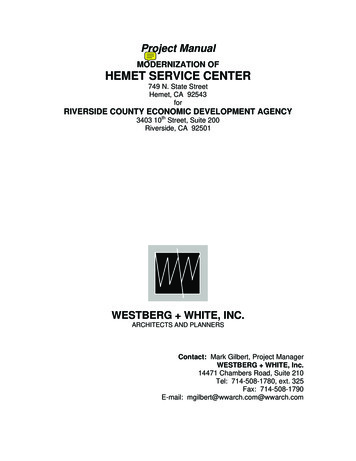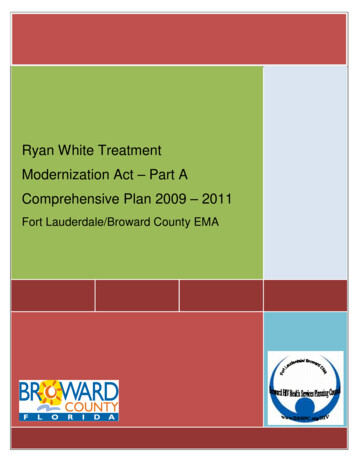
Transcription
Ryan White TreatmentModernization Act – Part AComprehensive Plan 2009 – 2011Fort Lauderdale/Broward County EMA2009- 2011 Ft. Lauderdale / Broward County RWHAP Part A Comprehensive HIV Services Plani
The creation of this document is 100% funded by a federal Ryan White HIV/AIDS Program PartA grant received by Broward County and sub-granted in part to Broward Regional HealthPlanning Council, Inc. (BRHPC). The findings and conclusions in this document are those of theauthors, who are responsible for its contents; the content does not necessarily represent theviews of Broward County of the Broward County Board of County Commissioners, the USDepartment of Health and Human Services (DHHS), or BRHPC. Therefore, no statement in thisreport should be construed as an official position of Broward County or the Broward CountyBoard of County Commissioners, the DHHS, or BRHPC.2009- 2011 Ft. Lauderdale / Broward County RWHAP Part A Comprehensive HIV Services Planii
Table of ContentsSection 1. Introduction . 1Section 2. Where Are We Now: What is Our Current System of Care? . 1A. Demonstrated Need . 11. HIV/AIDS Epidemiology . 12. Impact of Co-Morbidities on the Cost and Complexity of Providing Care . 83. Assessment of Emerging Populations with Special Needs. 144. Unique Service Delivery Challenges . 21B. The HIV Care Continuum: An Inventory of HIV Services. 241. Efforts to Find PLWHA Not In Care and Engage Them In Outpatient/ Ambulatory MedicalCare . 242. Community-Based HIV Clinical and Support Service Programs . 253. HIV/AIDS-Related Inpatient Hospital Admissions and Expenditures . 274. Adoption of Hospital-Based HIV Testing to Identify and Engage PLWHA Unaware ofTheir HIV Serostatus or Out of Care . 29C. Financing of the HIV Care Continuum. 301. Impact of RHAP Funding . 302. Trends in Part A Funding . 343. Medicaid Enrollment and Expenditures . 35D. Unmet Need . 371. Methods Used to Develop the Unmet Need Estimates . 372. Rationale for Choosing Estimation Method and FY 2008 Revisions . 383. Limitations to the Unmet Need Estimation Methodology . 384. Cross-Program Collaboration . 395. Assessing Unmet Need: Determining Demographics of PLWHA Not In Care . 396. Assessing Unmet Need: Determining Location of PLWHA Not In Care . 407. Assessing Unmet Need: Progress Assessing Needs, Gaps, and Barriers to Care. 418. Unmet Need Data Used In Priorities, Resource Allocations, and System DecisionMaking . 41E. FY 2009 Implementation Plan . 422. Where Do We Need To Go: What is Our Vision of an Ideal System? . 46A. Ideal HIV/AIDS Continuum of Care . 461. Shared Vision–Operational Definition of Continuum of Care and Core Services . 462009- 2011 Ft. Lauderdale / Broward County RWHAP Part A Comprehensive HIV Services Planiii
2. Shared Values for System Changes–Guiding Principles that Shape the HIV-RelatedSystem of Care in the Region. 463. How Will We Get There: How Does Our System Need to Change to EnsureAvailability of and Accessibility to Core Services? . 47A. EMA’s Established Continuum of HIV/AIDS Care and Access to Care . 471. FY 2009 - 2011 HIV/AIDS Service Implementation Plan. 474. How Will We Monitor Our Progress: How Will We Evaluate Progress in MeetingOur Short- and Long-Term Goals? . 53A. Improving Client-Level Data . 53B. Administrative Monitoring . 53C. QM Program and Plan . 561. Purpose and Mission Statements . 562. QM Infrastructure. 563. Roles and Responsibilities . 574. Annual Quality Outcomes and Indicators . 595. Participation of Stakeholders . 606. Performance Measurement . 617. Capacity Development. 618. Evaluation . 629. Process to Update the Annual QM Plan . 6210. Communication . 622009- 2011 Ft. Lauderdale / Broward County RWHAP Part A Comprehensive HIV Services Planiv
Acronyms Used in This PlanADAPAETCAHCAAICPAIDSAPAARVBARCBCHDBHPBRHPCAIDS Drug Assistance ProgramAIDS Education and Training CenterAgency for Health Care AdministrationAIDS Insurance Continuation ProgramAcquired immunodeficiency syndromeAIDS pharmaceutical assistanceAntiretroviralBroward Addiction Recovery CenterBroward County Health DepartmentBureau of Health ProfessionsBroward Regional Health PlanningCouncilCBOCommunity-based organizationCCBCoordinating Council of BrowardCDCCenters for Disease Control andPreventionCDTCChildren’s Diagnostic and TreatmentCenterCEOChief Executive OfficerCHCCommunity health centerCLASCulturally and Linguistically AppropriateServicesCLDClient level dataCQAClinical quality assuranceCQIContinuous quality improvementCTSCounseling and testing siteDAWN Drug Abuse Warning NetworkDCFDepartment of Children and FamiliesDEADrug Enforcement AgencyDOTDirectly observed therapyEDEmergency departmentEISEarly intervention serviceELRElectronic lab reportingEMAEligible Metropolitan AreaFDOC FL Department of CorrectionsFIMRFetal Infant Mortality ReviewFLFloridaFPLFederal Poverty LevelFQHC Federally Qualified Health CenterFYFiscal YearHAART Highly active retroviral therapyHABHIV/AIDS BureauHARSHIV/AIDS Reporting SystemHCSUS HIV Cost and Services UtilizationEvaluation StudyHIVHuman immunodeficiency virusHIVPC HIV Planning CouncilHOPWA Housing Opportunities for Persons WithAIDSHPHealthy PeopleHPSAHealth Professional Shortage AreaHRSAHealth Resources and ServiceAdministrationIDUInjecting drug userMAIMinority AIDS InitiativeMOUMemorandum of UnderstandingMSAMetropolitan Statistical AreaMSMMen who have sex with menMUPMedically Underserved PopulationsNIRNo identified riskNQCNational Quality CenterOIOpportunistic infectionOOSOut of StatePCPPneumocystis carinii pneumoniaPDSAPlan-Do-Study-Act CyclePHSPublic Health ServicePLWHA Person living with HIV/AIDSQAQuality assuranceQIQuality improvementQIPQuality improvement projectQMQuality managementRARERapid Assessment Response EvaluationSCHIP State Children’s Health InsuranceProgramSCSNStatewide Coordinated Statement ofNeedSPMISevere and persistent mental illnessSPNSSpecial Projects of National SignificanceSSASocial Security AdministrationSSISupplemental Security IncomeSTISexually transmitted infectionTATechnical assistanceTANFTemporary Assistance to Need FamilyTBTuberculosisTOTTraining of TrainersVAVeterans AdministrationWICYWomen, infants, children, and youthZIPZone Improvement Plan Code2009- 2011 Ft. Lauderdale / Broward County RWHAP Part A Comprehensive HIV Services Planv
Section 1. IntroductionThe Part A program is authorized by Part A of Title XXVI of the Public Health Service (PHS) Act,as amended by the Ryan White HIV/AIDS Treatment Modernization Act of 2006. The HIV/AIDSBureau (HAB) of the Health Resources and Services Administration (HRSA) operates programsfunded by the Treatment Act. HAB refers to these programs as the Ryan White HIV/AIDSProgram (RWHAP).Part A funds provide direct financial assistance to Eligible Metropolitan Area (EMA) orTransitional Grant Areas (TGAs) that have been severely affected by the HIV epidemic. Part Aformula and supplemental grants assist eligible program areas to develop or enhance access toa comprehensive continuum of high quality, community-based care for low-income individualsand families with HIV.Part A program grantees are responsible for planning for and organizing a comprehensivecontinuum of HIV care that may include up to 13 core medical services specified in theTreatment Act. HAB requires that Part A grantees use no less than 75% of grant funds (afterreductions for program administration and quality management), for core medical services thatare needed in the EMA/TGA. Part A funds may be used for: outpatient and ambulatory healthservices; (2) AIDS Drug Assistance Program (ADAP) treatments in accordance with Section2616 of the PHS Act; (3) AIDS pharmaceutical assistance (APA); (4) oral health care; (5) earlyintervention services (EIS); (6) health insurance premium and cost sharing assistance for lowincome individuals in accordance with Section 2615; (7) home health care; (8) medical nutritiontherapy; (9) hospice services; (10) home and community-based health services as definedunder Section 2614(c); (11) mental health services; (12) substance abuse outpatient care; and(13) medical case management, including treatment adherence services.Comprehensive HIV/AIDS care beyond these core services may include support services thatmeet the criteria of enabling individuals and families living with HIV/AIDS to access and remainin primary medical care and improve their clinical outcomes. No more that 25% of Part A fundsmay be used for support services as defined by the RWHAP as: case management (nonmedical); child care services; emergency financial assistance; food bank/home-delivered meals;health education/risk reduction; housing services; legal services; linguistics services; medicaltransportation services; outreach services; psychosocial support services; referral for healthcare/supportive services; rehabilitation services; respite care; and treatment adherencecounseling.Part A grantees were required to submit to HAB a comprehensive plan in January 2006.Grantees were instructed in HAB correspondence dated June 6, 2008 that they must updatetheir comprehensive plan and submit it to HAB by January 5, 2009. The updated plan mustaddress the organization and delivery of health and support service in their EMA/TGA. The planmust include appropriate strategies, goals, and timelines. In developing the plan, Part Agrantees should incorporate the legislative requirements under section 2602 (b) (4) (D) of theTreatment Act.Part A grantees are required by HAB to consider how they will evaluate and report on thedegree of success or failure achieved by funded initiatives undertaken to improve and maintaina system of care that is responsive to the change epidemic in their EMA. HAB requires granteesto update their plan to reflect an HIV comprehensive care that: Ensures availability and quality of all core medical services in the EMA/TGA; Eliminates disparities in access to core and support services for individuals with HIV amongdisproportionately affected sub-populations and historically underserved communities;2009- 2011 Ft. Lauderdale / Broward County RWHAP Part A Comprehensive HIV Services Plan1
Specifies strategies for identifying individuals who know their HIV status but are not in care,informing them about available treatment and services, and assisting them in using thoseservices; Includes a discussion of clinical quality measures; Includes strategies that address the primary health care and treatment needs of individualswho know their HIV status and are not in care, as well as the needs of individuals currentlyin the HIV/AIDS care system; Provides goals, objectives, timeliness, and appropriate allocation of funds, as determined bythe grantees’ needs assessment. Includes strategies to coordinate the provision of service programs for HIV prevention,including outreach and EIS; and Includes strategies for preventing and treating substance abuse.HAB requires that the comprehensive plan must include data from local needs assessmentsthat meet legislative requirements. Identified needs, particularly for HIV-related core services,should be a primary impetus for developing the comprehensive plan, guiding the EMA/TGA insetting goals, identifying clinical performance measures, and making resource allocationdecisions.The Ft. Lauderdale/Broward County EMA has developed a comprehensive plan that addressesHAB’s requirements, while addressing increased demand for HIV services, limited State andlocal funds, and HAB’s payer of last resort requirements.Section 2 addresses the questions, “Where are We Now?” and “What is Our Current System ofCare?” We summarize trends in HIV epidemic in Broward County, emerging populations, thecurrent HIV/AIDS service systems, trends in HIV public funds, and estimation of unmet need.Section 3 addresses the questions, “Where do we need to go?” and “What is our vision of anideal system?” This section reflects the input of key stakeholders including the HIV PlanningCouncil (HIVPC), other RWHAP grantees, consumers, and others to develop a shared vision forsystem changes. In a community planning process, this group developed an operationaldefinition of the continuum of care, and core and support services. The group also identifiedshared values for system changes and guiding principles that shape the HIV-related system ofcare in the Ft. Lauderdale/Broward County EMA. The group addressed the StatewideCoordinated Statement of Need (SCSN), the Florida Part B comprehensive plan, costeffectiveness, high quality services, and other environmental consideration.Section 4 addresses the questions, “How Will We Monitor Our Progress?” and “How Will WeEvaluate Progress in Meeting Our Short- and Long-Term Goals?” This sections summarizes theprocess undertaken by the Grantee to implement a new client level data (CLD) system tomonitor utilization to care, quality of services provided, and the impact of serviced provided. Thesection also describes the Part A quality program and long-term plan, and its application inmonitoring quality of care and subgrantee performance. The process for monitoring clinicaloutcomes is described. The section also discusses approaches for monitoring theimplementation of the comprehensive plan, and ensuring its timely implementation.2009- 2011 Ft. Lauderdale / Broward County RWHAP Part A Comprehensive HIV Services Plan2
Section 2. Where Are We Now: What is Our Current System of Care?A. Demonstrated Need1. HIV/AIDS EpidemiologyIn the last two decades the HIV/AIDS prevalence in the Fort Lauderdale/Broward CountyEligible Metropolitan Area (EMA) in Florida (FL) has remained consistently high relative to thetop ranked five EMAs (Source: Centers for Disease Control and Prevention (CDC), HIV/AIDSSurveillance Report). For brevity, we refer to the EMA as Broward County.Through December 2007, 24,257 Broward County residents were diagnosed with AIDS or HIV(non-AIDS), with 14,357 (69%) persons living with HIV/AIDS (PLWHA). Among living PLWHA,7,680 have AIDS (53%) and 6,677 have HIV (non-AIDS) (47%). Tables 1 and 2 summarizesHIV/AIDS case data in the EMA by demographic and HIV exposure categories assigned by theFL Department of Health (FDOH). Data presented in Tables 1 and Table 2 exclude EMAresidents incarcerated in the FL Department of Corrections (FDOC).FDOH reported 1,403 new AIDS cases diagnosed in the EMA for the two-year period betweenJanuary 1, 2006 and December 31, 2007. This figure significantly under-estimates the numberof AIDS and HIV (non-AIDS) cases diagnosed during this period due to implementation of a FLlaboratory reporting law that went into effect on November 20, 2006. Under the new law,laboratories processing detectable viral load tests ( 75 copies/mL) or CD4 tests below 200 (or14%) are required to submit an electronic case report to FDOH. In 2007, laboratories switchedfrom paper to electronic lab reporting (ELR). Due to technical difficulties, tests conducted in2007 were not retrievable from the ELR in 2007. In January 2008, FDOH staff conducted aretrospective review of Western Blot and viral load tests. FDOH staff reported in March 2008 tothe Broward County Part A grantee, that at least 1,300 AIDS and HIV (non-AIDS) case reportssubmitted for tests performed in 2007 were not investigated and submitted to the FDOH. Thus,incidence and prevalence estimates presented in this application are likely to significantly underestimate the number of HIV seropositive Broward residents. Seeming trends in AIDS and HIV(non-AIDS) incident cases may in fact have increased rather than decreased in 2007. The PartA Grantee has discussed with FDOH and HAB this matter, as it presents a serious challenge inaccounting and planning for newly identified AIDS and other HIV seropositive Browardresidents. Despite the challenge of accurately measuring the size of the HIV/AIDS epidemic inBroward County, the impact of the epidemic remains profound. Broward continues to ranksecond in AIDS cases per 100,000 population in the US, only surpassed in population-adjustedAIDS case rates by Miami/Dade County(Source: CDC, HIV/AIDS Surveillance Report). One in125 Broward County residents live with HIV/AIDS, compared to one in 218 Floridians.Broward County has effectively addressed its pediatric AIDS epidemic. In response toBroward’s ranking as fourth in pediatric AIDS cases through 2006, the HIV care system hascreated effective systems to prevent perinatal HIV infection. For example, 112 known births toHIV seropositive mothers were identified in 2007 (Broward County Health Department). Throughthe rap
2009- 2011 Ft. Lauderdale / Broward County RWHAP Part A Comprehensive HIV Services Plan ii The creation of this document is 100% funded by a federal Ryan White HIV/AIDS Program Part A grant received by Broward Co
